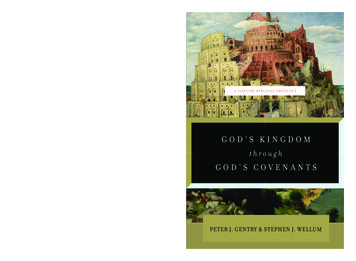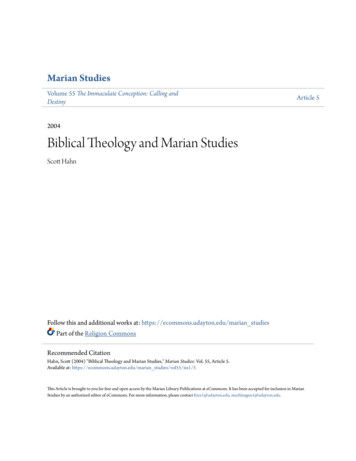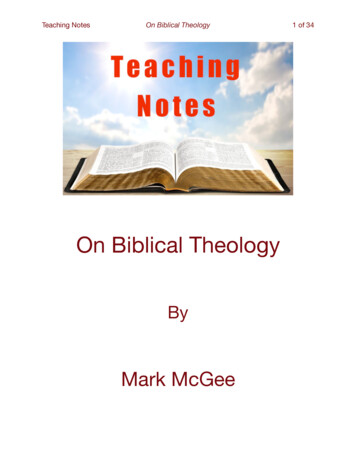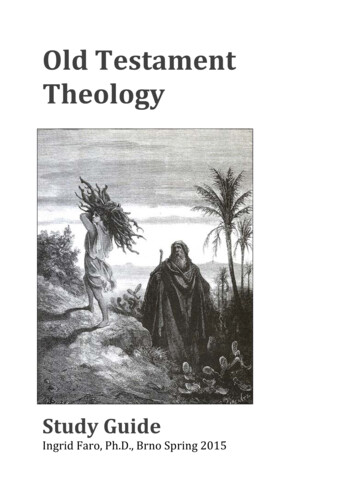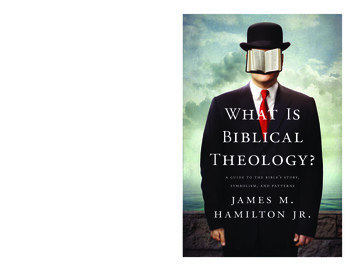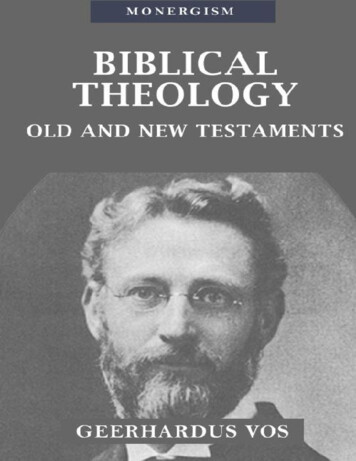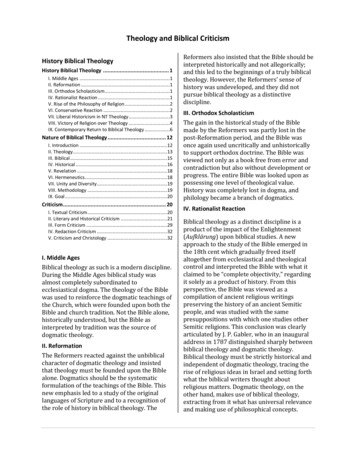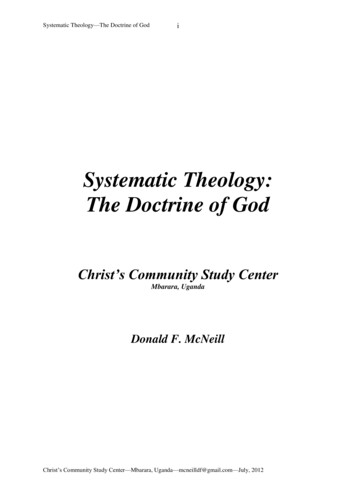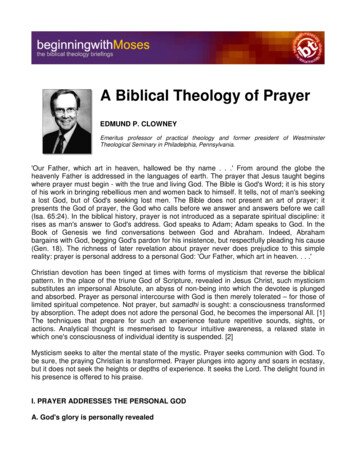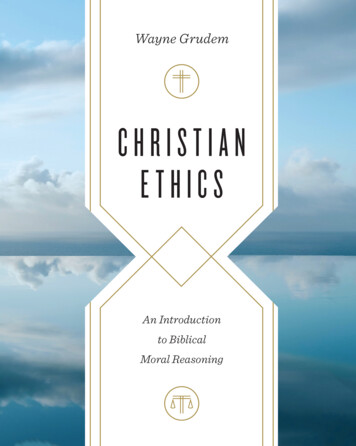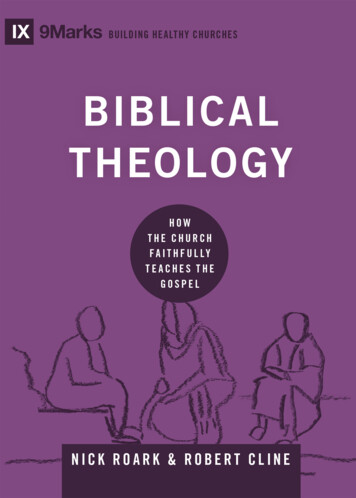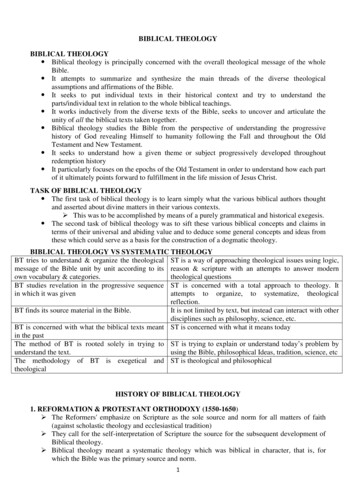
Transcription
BIBLICAL THEOLOGYBIBLICAL THEOLOGY Biblical theology is principally concerned with the overall theological message of the wholeBible. It attempts to summarize and synthesize the main threads of the diverse theologicalassumptions and affirmations of the Bible. It seeks to put individual texts in their historical context and try to understand theparts/individual text in relation to the whole biblical teachings. It works inductively from the diverse texts of the Bible, seeks to uncover and articulate theunity of all the biblical texts taken together. Biblical theology studies the Bible from the perspective of understanding the progressivehistory of God revealing Himself to humanity following the Fall and throughout the OldTestament and New Testament. It seeks to understand how a given theme or subject progressively developed throughoutredemption history It particularly focuses on the epochs of the Old Testament in order to understand how each partof it ultimately points forward to fulfillment in the life mission of Jesus Christ.TASK OF BIBLICAL THEOLOGY The first task of biblical theology is to learn simply what the various biblical authors thoughtand asserted about divine matters in their various contexts. This was to be accomplished by means of a purely grammatical and historical exegesis. The second task of biblical theology was to sift these various biblical concepts and claims interms of their universal and abiding value and to deduce some general concepts and ideas fromthese which could serve as a basis for the construction of a dogmatic theology.BIBLICAL THEOLOGY VS SYSTEMATIC THEOLOGYBT tries to understand & organize the theological ST is a way of approaching theological issues using logic,message of the Bible unit by unit according to its reason & scripture with an attempts to answer modernown vocabulary & categories.theological questionsBT studies revelation in the progressive sequence ST is concerned with a total approach to theology. Itin which it was givenattempts to organize, to systematize, theologicalreflection.BT finds its source material in the Bible.It is not limited by text, but instead can interact with otherdisciplines such as philosophy, science, etc.BT is concerned with what the biblical texts meant ST is concerned with what it means todayin the pastThe method of BT is rooted solely in trying to ST is trying to explain or understand today’s problem byunderstand the text.using the Bible, philosophical Ideas, tradition, science, etcThe methodology of BT is exegetical and ST is theological and philosophicaltheologicalHISTORY OF BIBLICAL THEOLOGY1. REFORMATION & PROTESTANT ORTHODOXY (1550-1650) The Reformers' emphasize on Scripture as the sole source and norm for all matters of faith(against scholastic theology and ecclesiastical tradition) They call for the self-interpretation of Scripture the source for the subsequent development ofBiblical theology. Biblical theology meant a systematic theology which was biblical in character, that is, forwhich the Bible was the primary source and norm.1
Protestant Orthodoxy The Bible came to be viewed as a uniform sourcebook of quotations whose primary task was tosupport the dogmas/doctrines of Protestant orthodoxy against the dogmas of RomanCatholicism. The understanding of biblical theology reflected in Protestant orthodoxy may be characterizedas "dogmatic Biblicism" or proof-texting2. EMANCIPATION FROM DOGMATICS (1650-1800): PIETISM & ENLIGHTENMENTPietism Pietism was a revolt within the German Church against Protestant scholasticism, for beingexcessively preoccupied with dogmatic speculations and dry concepts. Pietism stressed personal experience and awareness of the presence of God, as nourishedthrough a life of prayer, personal devotion, Bible reading, and moral living. Pietism's emphasis on the reading and study of Scripture by all brought about a greaterfamiliarity with the contents of the Bible. The back-to-the-Bible emphasis of Pietism brought about a changing direction for Biblicaltheology. "As early as 1745 “Biblical theology” is clearly separated from dogmatic (systematic) theologywhere biblical theology is conceived of as being the foundation of systematic theology.* Now Biblical theology can become the rival of dogmatics and turn into a completely separate andindependent discipline.Enlightenment Rejection of any form of supernaturalism Human reason was set up as the final criterion and chief source of knowledge The authority of the Bible as the infallible record of divine revelation was rejected. The development of a new hermeneutic, the historical-critical method’s. The Bible simply became one of the ancient documents, to be studied as any other ancientdocument. The Bible is a purely historical document and is to be investigated with a purely historical andthus critical methodology. As a result Biblical theology can be nothing else but a historical discipline which stands inantithesis to traditional dogmatics.Johann Philipp Gabler and the Division of Biblical Theology and Dogmatic Theology (17531826) Biblical theology is historical in character; that is, it sets forth what the sacred writers thoughtabout divine matters. Dogmatic theology is didactic in character, teaching what a given theologian thinks aboutdivine matters in accordance with his ability, his particular circumstances, age, locale, religiousand intellectual tradition, and similar conditioning factors.Task of Biblical Theology The first task of biblical theology was to learn simply what the various biblical authors thoughtand asserted about divine matters in their various contexts. This was to be accomplished bymeans of a purely grammatical and historical exegesis. The second task of biblical theology was to sift these various biblical concepts and claims interms of their universal and abiding value and to deduce some general concepts and ideas fromthese which could serve as a basis for the construction of a dogmatic theology.3. INFLUENCE OF RATIONALISM (1750-1875) The Bible was now understood in terms of an evolutionary religious process leading fromlower forms of religion to the absolute or universal religion. It was usually defined as a religion of reason (deism) or morality (Kant). Only those teachings of Scripture which were in accord with reason, were of abiding value.2
G. L. Bauer & the Division of OT and NT Theology (1797) The increasing recognition of the diversity of Scripture: especially the distinct differences incontent, historical context, and outlook between the testaments, which made it more difficult totreat them as homogenous documents The sheer increase in data and new discoveries pertaining to the Bible Made it more difficultfor anyone to master the entire field of biblical studies. Thus specialization became a necessity. The rationalistic devaluation of the OT in favor of the NT undoubtedly contributed to thisbifurcation in biblical theology.The Task of OT Theology To trace the religious ideas of the Hebrews in their historical development and against thebackground of other ANE religions with whom the Hebrews came into contact. Historical interpretation must trace the development of those ideas and interpret them inindependence from dogmatic theology's definitions. In the course of their development, in the Old Testament as in history generally, ideas movefrom particular to universal, and it is these universal religious ideas that are most important forthe present. OT & NT deserve to be heard on their own terms before their ideas are incorporated intodogmatic theology.Wilhelm Martin Leberecht de Wette Old Testament theologians must seek to understand the feelings and universal truths behind themyths. He adopted the Hegelian philosophy of thesis (nature religion) – antithesis (spiritual religion Hebrew religion) – synthesis (absolute or universal religion Christianity) Result: Old Testament was a lower religious state that had to be completed for the NewTestament to emerge4. REACTIONS AGAINST RATIONALISMG. F. Oehler Oehler accepts the division of OT and NT theology, but views that OT theology can functionproperly only within the larger canonical context. OT theology is a "historical science which is based upon grammatical-historical exegesiswhose task is to reproduce the content of the Biblical writings according to the rules oflanguage under consideration of the historical circumstances during which the writingsoriginated and the individual conditions of the sacred writersSIGNIFICANCE OF EXODUS EVENTS1. INTRODUCTIONThe Exodus is an amazing series of events that provide a key for interpreting the Pentateuch. Morepointedly, God’s deliverance in the exodus occasioned the beginning of writing Scripture. No otherOT motif is as crucial as to understand than the exodus. No other event is so basic to the fabric ofboth Testaments. Our concepts of deliverance and atonement, of God dwelling with his people, of Godtaking a people for himself and so forth have their roots in this complex of events. The motif of theexodus is one of the unifying images of the Bible. It sums up the story of OT redemption. In the NTthis literal deliverance is metaphorically and spiritually fulfilled in the atonement of Christ. As aresult, for Christians, it is the background to understand the death of Christ as the .lamb that was slain.The text of Exodus is the culmination of many recitations of the story for generations as instructed byGod with institution of Passover celebration (Exodus 12:24-27). The text is a faithful retelling of thestory. It concerned primarily to give theological meaning to the story of the people of Israel.2. MOTIFIC LANGUAGEThe following sub plots and images seem to be used as motifs in the Bible with reference to theexodus: tabernacle, altar, desert, wilderness, wandering, forty years, mountain of God, dark cloud,3
pillar of fire/cloud, divine warrior, arm/hand of the Lord, leading, shepherding, carrying, highway inthe wilderness, oppression, deliverance from oppression, dividing waters, plagues, judgments,miracles, mighty deeds, Passover, firstborn spared, banquet (Ex 24), the rock in the wilderness, waterfrom the rock, manna, riding on eagles’ wings, theophany, mediator, voice of God, covenant, andimages related to law and lawgiving.3. METAPHORIC MEANINGSThe central meaning of the exodus is deliverance or salvation. For this reason the exodus became theground or rationale for Israel’s obedience, identity and belief. Concerning obedience, the exodus is thebasis on which God calls Israel to enter into covenant relationship with him (Ex 20:2; Deut 5:6); and itis also the basis on which Israel is to treat aliens, slaves and others with deference (Deut 15:12–18).Concerning identity, the exodus is that moment in which God forged Israel as his people (Ex 19:5), akingdom of priests (Ex 19:6) and a nation independent of the dominion and rule of other nations.Concerning belief, the exodus is the evidence for trusting in the power, lordship, righteousness andlove of God. He is able to deliver by means of great power (Deut 4:32–35), he acts for the oppressed(Deut 10:12–22), and he acts out of love (Deut 7:7–8). The exodus motif was used by prophets andpoetic writers to transfer the significance of the original exodus to new situations requiringdeliverance, obedience, identity or belief. For example, Isaiah uses exodus imagery to evoke in hislisteners faith and hope that God will lead a second exodus and bring the Israelites out from exile withthe same wondrous deeds and power he displayed in the exodus from Egypt (Is 40:1–11).4. THE EXODUS MOTIFS IN OTThe first motific use of the exodus is found in Joshua 4:19–24, where the parting of the Red Sea isexplicitly likened to the parting of the river Jordan. The broad strokes of the use and development ofthe exodus motif in the OT might go something like this: The entry into and conquest of the PromisedLand in Joshua is the exodus experience of the next generation. The book of Judges is structuredaround cycles of oppression and deliverance for Israel by the hand of the Lord as they cried out forhelp. The books of Samuel-Kings can be seen as a movement from the impermanence of the exoduswanderings to a stable situation with king and temple and then the ultimate reversion back to anoppressive situation. The prophets transform the original exodus into a new exodus. In the same waythat God delivered Israel from Egypt in the past, he will deliver Israel in the future from bondage inthe exile.5. EXODUS MOTIFS IN NTThe NT borrows the exodus motif in a number of instances: John the Baptist’s ministry is summarizedin the words of Isaiah 40:3–4 as the one “preparing the way in the wilderness.” Jesus is the newMoses, who spent forty days in the wilderness without eating and who gives a sermon on the mountainto bring new light to the law. Indeed, when Jesus speaks of his resurrection, he speaks of leading anexodus (Lk 9:31). 1 Corinthians 10:1–5 says that Christ is the rock that was there in the wilderness ofthe exodus. Hebrews links Moses and Jesus (Heb 3:1–18), the Israelite and the Christian (Heb 4:1–3),the tabernacle and the heavenly temple (Heb 9:1–10), and the high priest and Jesus (Heb 6:20).Moreover, Hebrews 12:18–24 suggests a move from Mt. Sinai to Mt. Zion (similar to what the prophetIsaiah is doing with his transformation of the exodus motif and his focus on Zion). Finally, the book ofRevelation has numerous examples of the use of the exodus motif (e.g., the plagues, a womandelivered on eagle’s wings to the desert [Rev 12:14]).6. IMPORTANT THEOLOGICAL SIGNIFICANCES6.1. Theology of CreationThe God who created leads Israel out of Egypt. God is a life-giving, life-preserving, life blessing God(Ex. 1:7). The deliverance of Israel is ultimately for the sake of all creation (Ex. 9:16). God’s intentionfor Israel to embody the creational blessing is directly opposed by Pharaoh. God’s redemptive activityis cosmic in its effects. Exodus 15 confesses that God’s victory at the sea is not simply a local orhistorical phenomenon but a cosmic one. God’s defeat of the powers of chaos results not simply in4
Israel’s liberation, but in the reign of God over the entire cosmos (Ex. 15:18). The plagues are in effecta reversal of God’s created order. They are the punishment and eventual destruction of the enemies ofGod by unleashing the chaotic forces of creation: water is affected (first plague); darkness returnswhere there had once been light (ninth plague; esp. 10:21); animals and other creatures suffer (e.g.,fifth plague); even humans die (tenth plague). In the end the Egyptians are destroyed by water as thewaters that God had once tamed at creation are unleashed. The Israelites, however, are immune fromthis creation reversal. They are, in fact, “created” by being brought through the parted waters (as werethe waters in Gen 1:6–10) and are formed into a holy nation.6.2. Knowledge of GodThe identity of Yahweh is set from the beginning and only needs to be unfolded. God does not remainunchanged by all that happens. God does some things that God has never done before; the interactionwith other characters also shapes the divine identity. God is not only one who is; God is also one whoin some sense becomes.6.3. Images for GodGod is the Lord God who gives the law and demands obedience. He is judge for both Egyptians andIsraelites. He is king (Ex. 15:18) and whose sovereignty distinct form that exercised by Pharaoh. It isPharaoh who is the unmoved mover. The God of Israel is a suffering God who feels the pain at thesuffering of his people. God is a divine warrior who wages war on behalf of his people (Ex. 15:3). Godis the ruler of the cosmic order. It is demonstrated by his activity: Natural world does not resist God;human being does. God is a compassionate sovereign who suffers with his people (Ex. 3:7). Godaccomplishes his purposes through people, including the Hebrew midwives and Moses. God is willingto go with what is possible for human being.6.4. Exodus as the Paradigm of LiberationThroughout history, Exodus has become the example of God bringing liberation to the oppressed. It isa basis for liberation theology. According to this Salvation becomes holistic; not merely for theconversion of individuals, but of society. It is God himself who hears the cry of his people and isdetermined to deliver them (Ex 3:7–10). He is ready to bring them across the sea despite apparentfailure (Ex 14:10–14). The dominant motif used to describe God’s role in this deliverance is that ofdivine warrior. Despite the fact that Israel was “armed for battle” (Ex 13:18), the battle to deliver theIsraelites is God’s battle: “The LORD will fight for you” (Ex 14:14). The angel of God leads theIsraelites to the sea and stands as a buffer between them and the Egyptian army at night (Ex 14:15–20). After crossing the sea, the Israelites recount in song the glorious deeds of their warrior God: “TheLORD is a warrior; the LORD is his name” (Ex 15:3)6.5. Israel’s Worship &Yahweh’s PresenceIsraelites moves from slaves of Pharaoh to worshipping Yahweh. Liturgical forms of Passover andhymn of Exodus 15 are central to meaning of Exodus. The tabernacle depicts the presence of Yahwehwith and in the midst of his people Israel. It is here that the Lord’s abiding presence with his people isseen. The simple fact of the mobility of the tabernacle further highlights its function as God’s abidingdwelling place with his people. Moreover, it is God’s holy presence with his people that is the issue.The Presence of Yahweh/Elohim guides the people in the proper route of Exodus (Exod 13:3, 17–18,21–22). The presence of Yahweh cleaves the sea to make way for Israel to cross it dry-footed, thenbrings the waters rushing in upon the Egyptians following (14:21–31). The Presence of Yahwehprovides for Israel’s need in the wilderness (15:22–27; 16:4, 9–16; 17:4–7). The Presence of Yahwehgives the principles by which Israel is to live in covenant (20:1–18). The Presence of Yahweh is at thecenter of the elaborate instructions for the media of worship in Exod 25–31 and of the account of theirconstruction and consecration in Exod 35–40.6.6. Law, Covenant, and Israel’s IdentityExodus tells the story of a people instead of the family story of Genesis. God saves the Israelites fromslavery before he gives them the law. The law is a gift to an already redeemed community. The law isnot the means by which the relationship with God is established; God redeems quite apart from human5
obedience. Law requires worship of God alone. Only God’s gracious forgiveness allows continuity ofthe relationship after the golden calf incident. The reception of the law on Mt. Sinai is the central focusof the Israelite emigration from Egypt. The law is not a burden; rather, it is God’s declaration of thepeople’s proper response to his presence to insure that it would remain. It is because the Israelites wereto become God’s “kingdom of priests” and “holy nation” that they received special instructionsindicating their responsibility in this relationship (Ex 19:5–6).GOD: GOD’S SELF-REVELATIONThe focal point of God’s revelation in the OT is his self-revelation to his people; the revelation of hisperson and character precedes and explains the revelation of his purposes. He revealed himselfthrough his mighty works, through events which are interpreted through the prophets. Rolf Rendtorffwrites: Yahweh (the Hebrew name for God) himself becomes visible in his powerful acts of salvation.He becomes revealed in them” God’s self-revelation always aimed to bring about a personalrelationship between God and his people. If communion is to be possible, we must know the characterof God, through his self-disclosure.Some Instances of God’s Self-RevelationGenesis 12: It presents the call of Abraham. He is asked to leave his country and his peopleand go to the land that God would show him. God does not identify himself here. This command isimmediately followed by a promise, (v.2) – “I will make you a great nation, and I will bless you. Thisblessing is for all people but it begins with the establishment of a relationship with Abraham.Genesis 15 and 17: In Gen 15:1, God once again appears to Abraham and promises to be hisshield and in 17:1, He identifies Himself with the name El Shaddai (presents the mightiness of Godagainst the frailty of humanity). God further gives these instruction: “Walk before me, and beblameless” (17:1). The response God requires is a moral one; from the start the relationship betweenGod and his people has a moral dimension. In Gen 17:4-6, Abram becomes Abraham, that is “Exaltedfather” becomes “father of a multitude”.Genesis 28:13: In this passage, God reveals himself to Jacob in a dream and identifies himselfas God of Abraham and Isaac. He repeats covenant promise, “I will give you this land.”In Gen 32:29, Jacob asks the name of the one wrestling with him. God does not answer this, but ratherblesses him. In this case God withheld it in his freedom. Time and again, God revealed himself to thePatriarchs and called them for special mission. Their lives took on significance far above that of theirneighbours. God wishes this people to be unique possession. He had chosen them as a object andvehicle of his blessing and presence in the world. God promised them earthly land and progressivelyrevealed himself to them.Exodus 3:2: Here we come to one of the most striking and decisive moments in God’s selfrevelation. In 3:2 God appears as the “angel of the Lord.” God sometimes appears through anintermediary and sometimes rather more directly, though because of sin perfect face to face encounteris impossible in this life (Ex 33:20) God says, “I am the God of your father, the God of Abraham, theGod of Isaac and the God of Jacob,” and then promises to deliver the people from Egypt. Moses – theshepherd become leader – is to be chosen instrument. Then Moses asks (Ex 3:13) what name he is togive to the children of Israel. It is clear the people will want to know who this is. What sort of personpromises to deliver them? He has been the God of their Fathers. What will he be to them now? God’sanswer is: I AM WHAT I AM, OR I WILL BE WHAT I WILL BE.Exodus 6:1-2: When Pharaoh does not respond to Moses’ request God again assures him ofhis deliverance, and as if to support his promises, identifies himself: “I am the Lord (Yahweh). Iappeared to Abraham, to Isaac and to Jacob, as God Almighty (El Shaddai), but by my name the Lord(Yahweh) I did not make myself known to them.The name Yahweh means the covenanting God, the God sustaining faithful relations with his people.Exodus19:4: God says to Moses: “You have seen what I did” . This emphasis has led some tosee a change in the way God appears from a direct communication – a person-to-person encounter – to6
revelation through his works. Deeds in the OT are proofs, tokens and elaborations of God’s presenceand cannot be understood apart from this background.Exodus 33:18-23: In these verses Moses asks that God show him his glory. Moses is atanother point of decision and wishes a more complete vision of God. God refuses a more completemanifestation, not because God must be invisible, but because man in his sinful condition cannot seehim and live (v.20) But he does promise to make his goodness pass before him (v.19) and proclaimshis name Yahweh. God wishes to show himself “in terms of his attributes rather than hisappearances”. God does not refuse absolutely to reveal himself but wishes to make known hischaracter, his goodness. As if to illustrate this need he passes by Moses and covers him with his hand(v.22) to protect him from his immediate presence, which Moses in his sin would have to experienceas wrath. In this very covering, then, God is not hiding his glory but showing it in a form that hissinful people can appreciate.Other References to God’s Self-RevelationsI Sam. 3:10-14 - God calls Samuel and without introducing himself announces that he is aboutto do a new thing in Israel: he will judge the house of Eli.Isaiah 6:1-5 - It is the revelation of the person and character of God that precedes Isaiah’s callas a prophet.Amos 3:7 – He explains that God does nothing without revealing it to his prophets.In all these appearances one is struck by the fact that while God appears to people he is at the sametime transcendent, having his person above the limits of the world. Though, he is high and lifted up inhis character and his being; the world itself cannot contain him.THE NATURE OF GOD: Media of Revelation1. The Angel of the LordIn the OT, the angel of the Lord might be only a messenger of God (the Hebrew word itself meansmessenger), distinct from God himself (2 Sam.24:16), or he might be identified with the Lord himselfspeaking in the first person (Gen.16:7-14, Jud.2:1, 4; 6:20-23, et al). He could be a bringer of blessing(Ex.32:34) or of judgment (2 Sam.24:16).2. The Face of GodIn the account of Moses’ request to see the glory of God, the face of God appears as the presence ofGod without restriction (Ex.33:20).God wishes to show himself “in terms of his attributes rather than his appearances”. God does notrefuse absolutely to reveal himself but wishes to make known his character, his goodness. As if toillustrate this need he passes by Moses and covers him with his hand (v.22) to protect him from hisimmediate presence, which Moses in his sin would have to experience as wrath. In this very covering,then, God is not hiding his glory but showing it in a form that his sinful people can appreciate.3. AnthropomorphismsWhile not a medium of God’s presence, this is perhaps the place to consider the use ofanthropomorphisms in the OT. Often God is spoken of (and refers to himself) in human terms. Godspeaks (Gen.1:3), converses (Lev.4:1), hears (Ex.16:12), sees (Gen.1:4), smells (I Sam.26:19,) has aface (Nu,6:25), a back (Ex.33:23) hands (Isa,14:27) and so forth.The Nature of God1. God is personalGod is personal in that he is the God who gives himself a name. God’s giving himself names serves toemphasize three things. First, a name stresses God’s presence among his people apart from anymaterial or visible aspect to this presence. God’s majesty and love are manifest clearly in his names,but his people are given no exhaustive knowledge of his essence. Secondly, the use of various namesreflects his dynamic intervention in the life of Israel. He is a restless activity. One name does notexhaust the character of God or the possibility of his care. Finally, all the names have to do withGod’s relation with his people. They do not identify God with any part of nature . He is activelyinvolved in the life of his people in various ways.7
a) ElEl (often appearing in compound names) is perhaps the oldest Semitic designation for God. The basicmeaning is a mighty leader or governor and stresses the distance between God and man, as well as hispower over nature.El Shaddai: It Stresses the exalted and mighty character of God (Gen 17:1 and forty times in Job)El Alion: The Most High God (Gen. 14-18-19)El Olam: God of ancient of Days, Everlasting God (Gen. 21:33; Isa. 40:28)El Roeh: God of seeing (Gen. 16:13)Elohim: It is very common, plural form of God (Gen. 1:1) . It sums up of the whole divine power in apersonal unity. Can also be associated with Trinityb) YahwehThis name is connected with the verb “to be” (Ex. 3:14 and Hos. 1:9) and is specifically Israel’sdesignation for God. After the time of Moses (Ex. 6:3), this becomes the name by which the worshipof Israel is marked off from all the other nations. It is the particular name of the covenant relationshipand thus speaks of God’s nearness and concern for his people (Deut. 3:4). The implications of thisfullness will one day be fully seen when God will be immediately present (Ezek. 37: 26-28).c) Lord Sabaoth (Lord of Hosts)The idea of this name is probably connected with God as a warrior as explained in I Sam.17:45. Thename may have been originally associated with God as a leader and deliverer of his people in battle.However, later this name was used simply as a designation for God’s exaltedness and omnipotence(especially in the prophets: Isa. 23:9; 24:23; Zech. 3:10).d) Melek (King)Exodus 15:18 speaks of the Lord reigning forever. God’s kingship is implicit in the covenant form ofthe early books of the Old Testament (Num. 23:21). The prophets of the 8 th century avoid it with theexception of Isaiah (6:5; 41:21; 44:6; 52:7). It is probable that they avoid it because of the falseworship of the melek cult in the 7th and 8th century. In the post-exilic thought the title king isassociated with God’s salvation at the last days (Zech. 14:16)2. God is SpiritThis definition of God which becomes so important in the NT is for the most part absent from the OT.Why is this so? We have noted already that the characteristic revelation of God lends itself toanthropomorphisms and focuses on the giving of his name. But it is important to note that spirit,whose basic meaning is wind or breath, had a concrete connotation in the OT.Some of the ways God is expressed in the OT are: He is the source of life (Ps.36:90) He does not sleep (Ps.121:4) He is the searcher of hearts (1 Sam16.7) There can be no limiting, materialistic expressions of him (Ex.20:4) He is supreme over all creatures (Isa.31:3) He is distinct from man (Hos.11:9).3. God is One: Monotheism The patriarchs’ practical experience was of God as supreme and alone, but we have noindication of their denial of the existence of other gods. The highest statement of pure monotheism comes with the major prophets. For them othergods are all as nothing (Isa.44:10; Jer 2:5). But even here the stress is on their worthlessnessrather than on their nonexistence: they cannot hear or answer prayer; therefore, they are nogods at all. Among all the wise ones there is none like the Lord; all others are stup
The Bible simply became one of the ancient documents, to be studied as any other ancient document. The Bible is a purely historical document and is to be investigated with a purely historical and thus critical methodology. As a result Biblical theology can be
